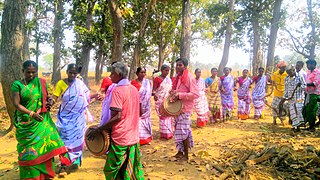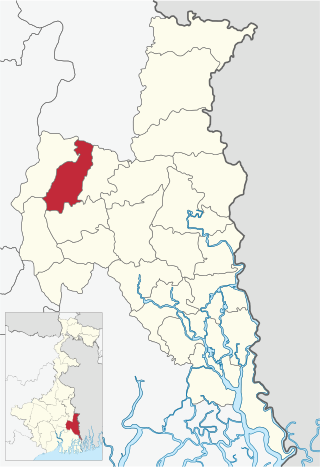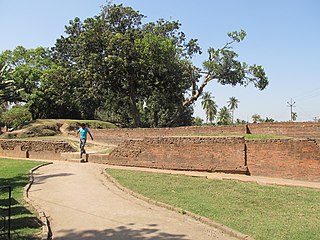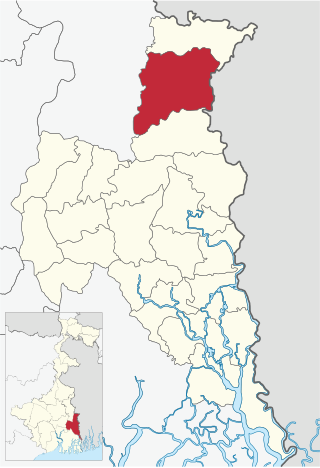
Santhal Pargana division constitutes six district administration units known as the divisions of Jharkhand state in eastern India.

The Santal people are an Austroasiatic-speaking Munda ethnic group of the Indian subcontinent. Santals are the largest tribe in the Jharkhand and West Bengal in terms of population and are also found in the states of Odisha, Bihar and Assam. They are the largest ethnic minority in northern Bangladesh's Rajshahi Division and Rangpur Division. They have a sizeable population in Nepal. The Santals speak Santali, the most widely spoken Munda languages of Austro-asiatic language family.

Tebhaga movement (1946–1947) was significant peasant agitation, initiated in Bengal by the All India Kisan Sabha of peasant front of the Communist Party of India.

Amdanga is a community development block that forms an administrative division in North 24 Parganas district in the Indian state of West Bengal.

Deganga is a community development block that forms an administrative division in North 24 Parganas district in the Indian state of West Bengal.
Mandirbazar is a community development block that forms an administrative division in Diamond Harbour subdivision of South 24 Parganas district in the Indian State of West Bengal.

Minakhan is a community development block that forms an administrative division in Basirhat subdivision of North 24 Parganas district in the Indian state of West Bengal.
The Mal Paharia people are a people of India, mainly living in the states of Jharkhand and West Bengal. They are the original inhabitants of the Rajmahal Hills, known today as the Santal Parganas division of Jharkhand. They are listed as a Scheduled Tribe by the governments of West Bengal, Bihar and Jharkhand. They speak the Malto language, a Dravidian language, as well as a poorly-documented Indo-Aryan Mal Paharia language.

Barasat I is a community development block that forms an administrative division in Barasat Sadar subdivision of North 24 Parganas district in the Indian state of West Bengal.

Basirhat I is a community development block that forms an administrative division in Basirhat subdivision of North 24 Parganas district in the Indian state of West Bengal.

Basirhat II is a community development block that forms an administrative division in Basirhat subdivision of North 24 Parganas district in the Indian state of West Bengal.

Bangaon is a community development block that forms an administrative division in Bangaon subdivision of North 24 Parganas district in the Indian state of West Bengal.
Bishnupur I is a community development block that forms an administrative division in the Alipore Sadar subdivision of the South 24 Parganas district in the Indian state of West Bengal.
Thakurpukur Maheshtala is a community development block that forms an administrative division in the Alipore Sadar subdivision of South 24 Parganas district in the Indian state of West Bengal.
Bhangar II is a community development block that forms an administrative division in the Baruipur subdivision of the South 24 Parganas district in the Indian state of West Bengal.
Diamond Harbour II is a community development block that forms an administrative division in the Diamond Harbour subdivision of the South 24 Parganas district in the Indian state of West Bengal.

Sarnaism is a religious faith of the Indian subcontinent, predominantly followed by indigenous communities in the Chota Nagpur Plateau region across states like Jharkhand, Odisha, West Bengal, Bihar, and Chhattisgarh. This belief centers around the reverence of Sarna, the sacred groves of village communities where the village deity, known as Gram deoti resides, and where sacrificial offerings are made twice a year. It is also referred to as "Sarna Dharma" or the "Religion of the Holy Woods", and it holds the distinction of being India's largest tribal religion.

Jungle Terry or Jungleterry, from Hindi: जंगल तराई jangal tarāi, meaning 'jungle lowland', was a term applied in the 18th century to an area bordering Bengal and Bihar that included large tracts of Bhagalpur and Monghyr districts, as well as the Santal Parganas district.

Deoghar subdivision is an administrative subdivision of the Deoghar district in the Santhal Pargana division in the state of Jharkhand, India.
The Museum of Santal Culture is a private community museum located in the village of Bishnubati, West Bengal. The community-led museum documents the history of the Santal community largely prevalent in the region, which includes their past, their memories, and traditional ways of being. The museum was co-founded by educator Dr. Boro Baski alongside other members of the village of Bishnubati, a Santali village of "less than 700 hundred people" in the Birbhum district of West Bengal.












